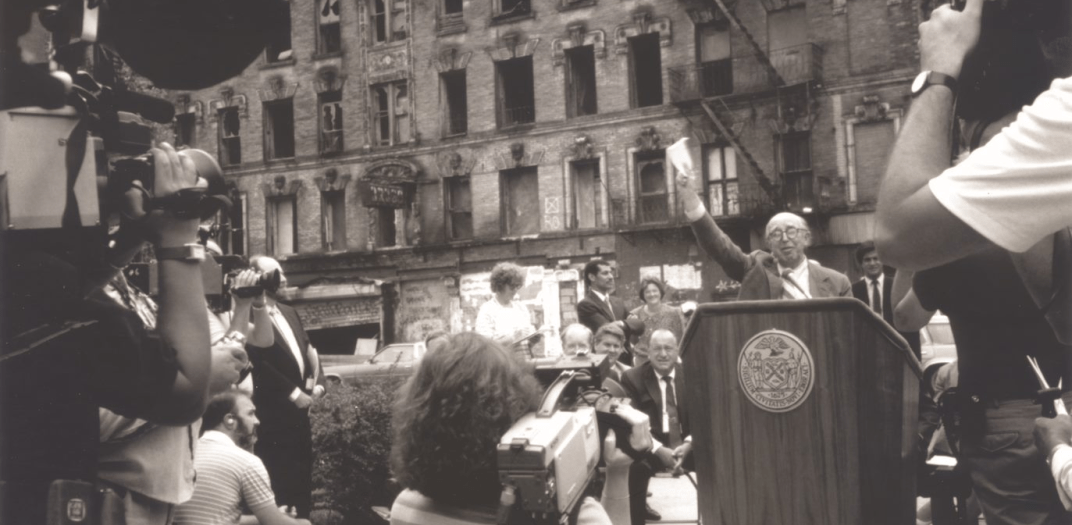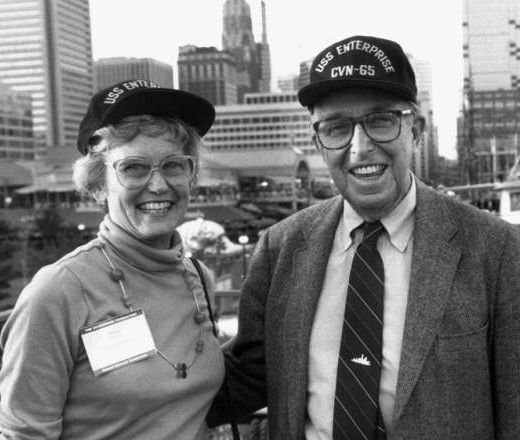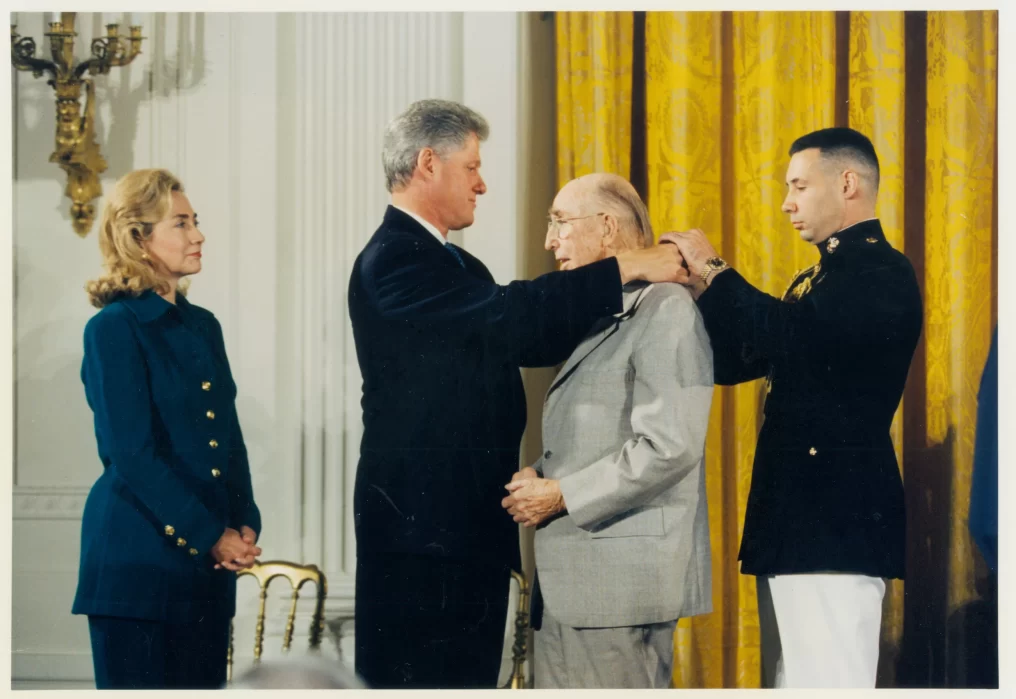50th Anniversary Stories
Jim Rouse: The Life and Legacy of an Urban Visionary
One of Jubilee Housing’s founders and long-time supporters was Jim Rouse. Jim befriended Reverend Gordon Cosby, who founded the Church of the Saviour in 1947 with eight others. Gordon became Jim’s spiritual advisor, and they became good friends and confidants as they both had an entrepreneurial spirit and were pioneers in their own ways—Jim in business and Gordon in founding a new type of church. Both shared a commitment to civil and social engagement and activism. It’s sometimes difficult to tell when Jubilee and the Church of the Saviour were leading Rouse into new ways of seeing and doing and when it was the reverse. Still, in the end, everyone benefitted from this unlikely match of a world-renowned developer and a small church focused on local activities and forming organizations in the Adams Morgan neighborhood that benefited Washington, DC, and developed an affordable housing model that Jim would later take nationally.
Born in 1914 in Easton, Maryland, James “Jim” Wilson Rouse grew up to become a visionary leader and pioneer in urban development, leaving an indelible mark on cities across America. He saw potential in every corner of the city, even in neglected neighborhoods where others saw only blight. Equipped with an entrepreneurial spirit and unwavering optimism, Jim set out to reshape the urban landscape to benefit all its inhabitants.
In 1939, Jim founded the James W. Rouse Company, later renamed The Rouse Company, a community developer that would become synonymous with groundbreaking projects and transformative urban renewal. His approach was revolutionary: he believed that cities should be designed with people in mind, not just for profit. Instead of cookie-cutter developments, he envisioned vibrant, inclusive communities where people could live, work, and play. He understood that housing was not just a basic need; it was the foundation upon which individuals and families could build better futures. Myra Peabody Gossens, Jubilee Housing Board Member Emerita, recounts how Jim inspired her through his inclusive approach to housing development, “When you get to know Jim Rouse, you get to know one thing. This is a man of possibilities. His mantra was if it ought to be, it can be. He believed deeply in people, and he believed that we needed to build community together.’”
Jim’s impact was felt far beyond Baltimore’s borders. He spearheaded projects like the city of Columbia, Maryland, a planned community designed to promote racial and socioeconomic diversity—a radical concept at the time. He also played a key role in developing Faneuil Hall Marketplace in Boston and Harborplace in Baltimore, iconic destinations that revitalized their respective cities. He would become known nationally for his developments and activism, appeared on the cover of Time magazine, become an advisor to several presidents, and received the Presidential Medal of Freedom, the highest civilian award, for his lifetime achievements. But perhaps one of his greatest achievements was sharing the inspiration he found from three young women and the Church of the Saviour members in founding Jubilee Housing in 1973 to thousands of others nationwide and globally to promote affordable housing. Already a successful businessman, urban planner, developer, and philanthropist, it was his connection to the Church of the Saviour in Washington, DC, that changed his life and set him on a course of sharing the Jubilee Housing model nationally.

Carolyn Banker Cresswell, Terry Flood, and Barbara Moore, and other members of the Church of the Saviour, envisioned a transformation in the Adams Morgan community. These three members approached Jim with an ambitious proposal: to acquire and revitalize the Ritz and Mozart apartment buildings. Despite lacking the necessary expertise in development, finance, and construction, their determination was unwavering. Jim initially harbored reservations. After his initial meeting, Jim’s advice was, “There is nothing you can do. You’re too little. You don’t have the resources. It takes a big program”, which was the conventional belief at the time. However, Terry, Barbara, and Carolyn were committed to providing their neighbors with safe, healthy, and compassionate housing. Demonstrating their dedication, the trio made a non-refundable deposit to purchase the buildings independently.
Inspired by their initiative and thankful they did not take his advice, Jim facilitated their endeavor by securing $625,000 for the acquisition and an additional $125,000 for repairs. This pivotal investment marked the inception of Jubilee Housing in 1973, an organization that would redefine the Adams Morgan, Columbia Heights, and Mount Pleasant neighborhoods in DC. Bart Harvey recalls how “Adams Morgan was not a place you stayed long in… there were a lot of buildings in disrepair that obviously needed help… this was an abandoned part of Washington, DC…Well, it didn’t stay that way very long. Jubilee Housing started the physical change and did such a remarkable job and helped so many people in the process that people and businesses moved in, and other people wanted to live there…And Adams Morgan just totally transformed how people looked at the neighborhood.”
Witnessing the profound impact of community-driven initiatives like Jubilee Housing, Jim and Patty Rouse were inspired to establish Enterprise Community Partners in 1982. Jim and Patty’s vision was to empower communities nationwide, amplifying the transformative potential of neighborhood groups and community organizations like Jubilee. Jim’s philosophy was “the best way to attack any problem is to ask what things would be liked if it worked… If a neighborhood is badly deteriorated and the people abandoned it, if people are living in miserable housing with 30-40% jobless, limited healthcare, and limited human services, we need to go into that neighborhood and ask ourselves what would it be like if it worked. Suppose the neighborhood was beautiful. Suppose every person had the opportunity to live in a healthy way and a healthy neighborhood. Suppose everyone had the opportunity to use their God-given capacity to cope in life… That ought to be a minimum goal in our society… We can’t just settle for doing some housing, finding some jobs, or building some human support systems. We must do it all—decent housing in decent neighborhoods for everyone.”
To Jim, it was extraordinary what Jubilee was doing, and he sought to institute the Jubilee Housing model nationally at Enterprise; “If [Jubilee] could do it, there must be thousands of others out there who would do it too—if only there was a process through which they could go to work. We went out to build that process…” With Enterprise, they sought to address the systemic issues contributing to housing insecurity and urban blight, employing a comprehensive approach that combined affordable housing development, community revitalization, and advocacy for policy change.

Throughout the years, Jim and Patty remained closely involved with Jubilee. Deeply invested in the vision, they served as board members of Jubilee Housing until their deaths. Jim invited business leaders and political figures, including five presidents, to the Potter’s House to introduce them to Jubilee’s vision and encourage them to prioritize affordable housing development, just as Jubilee had inspired him to do. President Jimmy Carter cut the ribbon for Jubilee’s Ontario Court Building in the late 70s.
After Jim retired from Enterprise, Bart Harvey, already deeply engaged in the organization, assumed leadership. Bart had long admired Jim and shared his vision for creating inclusive communities where everyone can thrive. When the opportunity arose to take over as CEO of Enterprise, Bart saw it as a chance to honor Jim Rouse’s legacy and continue the organization’s vital work. Under Bart’s leadership, Enterprise expanded its impact, trailblazing the people-centric approach to affordable housing and community development.
Together, Jim and Patty Rouse and Bart Harvey forged and fostered a legacy of compassion and innovation that continues to inspire generations of leaders in the affordable housing and community development field. Their dedication to creating a more just and equitable society lives on in the countless individuals and families whose lives have been transformed by the work of Enterprise.
In April 2024, Enterprise Community Partners celebrated its one millionth home created since 1982!

